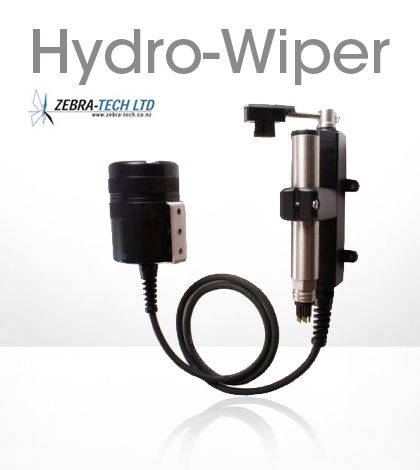Zebra-Tech’s Hydro-Wiper bolts on to maintain optical sensors in any condition

The world is an unpredictable place full of fouling and entanglements that can send just about anyone astray. Water quality data too can be severely compromised by unforgiving conditions and unpredictable events.
John Radford, Zebra-Tech’s founder, learned firsthand how fouling could degrade data quality to the point of being unusable. “Whilst working for the National Institute of Atmospheric Research in New Zealand, we had constant issues trying to make long-term measurements of suspended sediment concentrations in shallow coastal water,” he said. “Fouling of the sensors between site visits caused fatal degradation of the data quality. Attempts were made to develop a method for mathematically correcting the data, but these were unsuccessful.”
Given plaguing issues with fouled sensors, Radford started prototyping wipers to clean optical sensor faces. “I developed various wiper systems, including pneumatic (which were driven by dive tanks) and electromechanical, with varying degrees of success,” he said. “The first units used off-the-shelf toothbrushes.”
His inventive mind eventually led to the creation of a company dedicated to keeping sensors clean. That way, researchers and scientists could have reliable and accurate data filling up data loggers.
Six years later, Zebra-Tech manufactures wiper systems for 20 sensor platforms and recently manufactured their 1,000th wiper system. “With this number of Hydro-Wipers, there is a high probability that at any moment in time, day or night, at some place in the world, there is a Hydro-Wiper motor driving a brush that is keeping a sensor face clean,” Radford said. “This may be happening in a Pacific Island lagoon, the Great Barrier Reef, an Arctic lake, the Mississippi River, in coastal waters off Durban or the River Thames.”
Zebra-Tech’s Hydro-Wipers can be clamped onto optical sensors from Turner Designs, Campbell Scientific, Seapoint, LI-COR and many other instruments.
Users have the option of choosing between a self-contained Hydro-Wiper systems or a data logger controlled wiper. For self-contained wiping systems, users simply attach the wiper to their sensor, connect the electrical connectors and set a time interval. Data logger controlled wipers require a five volt signal to start a wipe cycle.
The wiper systems have a variety of failsafe design elements to prevent damage to the wiper and maintain sensors. Hydro-Wipers sense their position so they never park on a sensor face. When the wiper controller senses a slower wiping pace due to entanglements, it reverses wiping direction to unwind tangled debris. If the wiper is stuck against an object, a driveshaft slip mechanism prevents damage to the internal gearbox.
Radford also kept power supply in mind when designing the Hydro-Wiper. The wipers are designed to draw the minimum power necessary, 80 milliamps during a wipe cycle and 0.05 milliamps between wipes. If a monitoring system’s power falls below a minimum set point, the wiper will not wipe to preserve power.
All Hydro-Wiper components are machined in-house in a climate controlled facility to maintain high quality and tight tolerances for a long lasting product. “The high level of accuracy and standard of finish required makes it a timely process,” said Radford. “For example it takes around 20 minutes of machining time to create the main part of the wiper motor body in a computer controlled machining center.”
Then there are other tasks such as machining the wiper shafts in four different operations and building the motor and gearbox combination.
All that work and experience translates to a tough wiper system that will help maintain optical sensor accuracy, no matter how foul and entangling the water.




0 comments